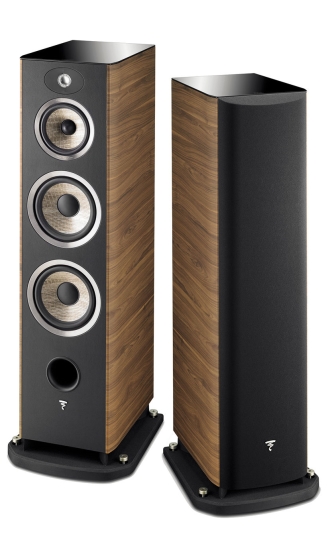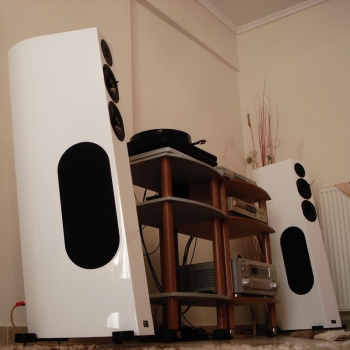Choosing stationary acoustics
We independently test the products and technologies that we recommend.
 |
|
Removable grill can cover the front side, and dual mid-woofers provide good bass |
At different times, stationary (aka floor standing) acoustics had various shapes and configurations. Now everything has stabilized around elongated vertical "towers", the depth of which most often exceeds the width. Inexpensive models have rectangular cases (they are also called "cabinets"). Note that cabinets with rounded, slanting walls avoid unwanted resonances and overtones, but at the same time increase the cost of the system.
The vast majority of modern stationary speakers are three- way, that is, they involve a high-frequency (tweeter), midrange (midrench) and low-frequency speaker (midwoofer, sometimes there can be two "woofers"). It is worth taking a closer look at the size (diameter) of the woofers - they are the largest. If their “caliber” is eight inches or less, the reproduction of the “bottom” is given to such a system with the help of considerable design tricks ... High-quality, light, but powerful and rich sound in the low-frequency range is one of the main advantages of stationary acoustics, “what it is for bought”, which should not be lost anyway. Indirectly, the ability to work in the low-frequency range is also indicated by the weight of the system - if it is, say, less than fifteen kilograms - there are reasons to be wary.
You should also pay attention to where the speakers and phase inverter ports “look”. Often the woofer is located on the side wall of the cabinet - in this case, between it and the nearest parallel surface, it is necessary to provide a gap of at least 10-15 centimeters (the more, the better). As for the bass reflex port, if it is directed backwards, then objects located behind and on the sides of the speaker begin to affect the reproduction of the "bottom". This influence is not always negative, but still. The main thing is to initially take into account that in this case the column will need free space around it and, most importantly, behind it.
And one more thing: the design of acoustics should be pleasant and fit well into the interior of the room where it will be located. And for many customers, unlike buyers, this item is almost in the first place!
 |
|
Patch panel provides option with two amplifiers |
Passport details are important!
Of all the "participants" in the process of sound reproduction (these include the signal source, amplifier, cables, acoustics), it is acoustics that contributes the largest share of distortion. At the same time, manufacturers indicate the measured coefficient of nonlinear distortion for speakers very rarely. Indirectly, the quality of playback can be assessed by the level of sensitivity of the system. Not bad if this figure is above 90 dB. It also indicates how high the efficiency, "return" of the columns. A difference of five decibels gives a loudness increase, subjectively estimated as “twice”.
It is also worth thinking about how large the room is to be voiced and to what volume. Here, such a parameter as “maximum recommended amplifier power” mainly works. It should not be less than the maximum power of the amplifier to which the acoustics will be connected. Sometimes the manufacturer himself gives recommendations in the passport, for example, about the area of \u200b\u200bthe room in which these speaker systems can be installed.
Be sure to pay attention to the impedance - the resistance of the speakers. Make sure that your amplifier works with such a resistance; there must be data on this in its passport.
The reproducible frequency range of modern acoustics at the “tops”, usually, obviously overlaps the perception threshold of our ears (that is, above 20 kHz). And the higher this figure, the better the acoustics will reproduce the so-called upper harmonics. As for low frequencies, here, perhaps, it is more important to pay attention to the uneven frequency response - the amplitude-frequency characteristic. Roughly speaking, if the system according to the passport reproduces 40 Hz but with a “blockage” of 10 dB, we can assume that these sounds will not impress the listener. The frequency response must be as linear, horizontal, and uniform as possible. The presence of "humps" or "hollows" deeper, say, three to five decibels, leads to problems with the reproduction of certain instruments, notes, parts.
On the other hand, it still does not make sense to get carried away with the analysis of technical characteristics, since many of them, by different brands, are interpreted differently, while using different testing options, coordinates and units of measurement.
Let's listen!
 |
| Option in which the side walls of the systems must be free |
Indeed, what could be simpler and more logical for choosing the right acoustics? Let's listen to the speakers and immediately understand everything! .. In fact, everything is a little more complicated. For example, an attempt to listen to the system on the trading floor is initially a failure. In a loud, large room, even an expert will not be able to understand anything. In a special showroom, a listening room, you can and should listen. But this is worth preparing for. Everything is simple. For starters, do not trust the phonograms that the sellers will offer you to listen to. This is usually a gimmick. They will offer demo CDs that have been recorded just to "compliment" almost any system.
You need to take with you a recording that has already been heard many times, familiar, familiar in all nuances, about which it is known exactly how it should sound. We also take into account that an amplifier and source are installed in the demo hall, which are different from those with which the speakers will work at your home. Therefore, we strictly make sure that when listening, all sound processing is turned off, in particular, timbres - the timbre knobs are set to “zero”, or the flat mode is turned on (bypassing the timbre block) - there are enough options.
Pay attention to the purity of the sound, the accuracy of work at different volume levels, the "non-disappearance" of different frequency ranges, and so on, and most importantly - trust your feelings!
And, having fulfilled all these (and perhaps not only these) recommendations, make the only right choice.
Read also:
Amplifier for acoustic system
What should you pay attention to when choosing a transistor amplifier for your acoustics?
How to choose a subwoofer?
What you need to know to choose a subwoofer for your stereo system or home theater.
Choosing shelf speakers
Dimensions are important for bookshelf acoustics, but this is only the first thing you should pay attention to.
Articles, reviews, useful tips
All materials












